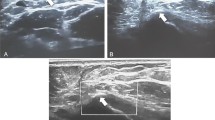Abstract
Objective
To highlight focal bone abnormality in the cuboid due to tendinopathy of the adjacent peroneus longus.
Design
A retrospective review was carried out of the relevant clinical and imaging features.
Patients
Two male and two female patients were studied, mean age 51.5 years (range 32―67 years), referred with foot pain and imaging showing an abnormal cuboid thought to represent either tumour or infection.
Results
A long history of foot pain was usual with a maximum of 8 years. Radiographs were normal in two cases and showed erosion in two, one of which exhibited periosteal new bone formation affecting the cuboid. Bone scintigraphy was undertaken in two patients, both of whom showed increased uptake of isotope. MRI, performed in all patients, showed oedema in the cuboid adjacent to the peroneus longus tendon. The tendon and/or paratendinous tissues were abnormal in all cases, but no tendon discontinuity was identified. One patient possessed an os peroneum. Unequivocal evidence of bone erosion was seen using MRI in three patients, but with greater clarity in two cases using CT. Additional findings of tenosynovitis of tibialis posterior, oedema in the adjacent medial malleolus and synovitis of multiple joints in the foot were seen in one patient. Imaging diagnosis was made in all cases avoiding bone biopsy, but surgical exploration of the peroneal tendons was performed in two cases and biopsy of ankle synovium in one.
Conclusions
Oedema with erosion of the cuboid bone, simulating a bone lesion (cuboid “pseudotumour”), may be caused by adjacent tendinopathy of peroneus longus. It is vital to be aware of this entity to avoid unnecessary biopsy of the cuboid.




Similar content being viewed by others
References
Dombek M, Lamm B, Saltrick K, Mendicino R, Catanzariti A. Peroneal tendon tears: a retrospective review. J Foot Ankle Surg 2003; 42:250―258.
Rademaker J, Rosenberg Z, Delfaut E, Cheung Y, Schweitzer M. Tear of the peroneus longus tendon: MR imaging features in nine patients. Radiology 2000; 214:700―704.
Khoury N, El-Khoury G, Saltzman C, Kathol M. Peroneus longus and brevis tears: MR imaging evaluation. Radiology 1996; 200:833―841.
Weishaupt D, Schweitzer M. MR imaging of the foot and ankle: patterns of bone marrow signal abnormalities. Eur Radiol 2002; 12:416―426.
Morrison W, Carrino J, Schweitzer M, Sanders T, Raiken D, Johnson C. Subtendinous bone marrow edema patterns on MR images of the ankle: association with symptoms and tendinopathy. AJR Am J Roentgenol 2001; 176:1149―54.
Boles M, Lomasney L, Demos T, Sage R. Enlarged peroneal process with peroneus longus tendon entrapment. Skeletal Radiol 1997; 26:313―315.
Burman M. Subcutaneous tear of the tendon of the peroneus longus. Arch Surg 1956; 73:216―219.
Peacock K, Resnick E, Thoder J. Fracture of the os peroneum with rupture of the peroneus longus tendon: a case report and review of the literature. Clin Orthop 1986; 202:223―226.
Mains D, Sullivan R. Fracture of the os peroneum: a case report. J Bone Joint Surg Am 1973; 55:1529―30.
Sammarco G. Peroneus longus tendon tears: acute and chronic. Foot Ankle Int 1995; 16:245―253.
Burman M. Stenosing tenovaginitis of the foot and ankle. Arch Surg 1953; 67:686–698.
Saxena A, Pham B. Longitudinal peroneal tendon tears. J Foot Ankle Surg 1997; 36:173―179.
Sobel M, Geppert M, Hannafin J, Bohne W, Arnoczky S. Microvascular anatomy of the peroneal tendons. J Foot Ankle Surg 1992; 13:469―472.
Petersen W, Bobka T, Stein V, Tillmann B. Blood supply of the peroneal tendons: injection and immunohistochemical studies of cadaver tendons. Acta Orthop Scand 2000; 71:168―174.
Benjamin M, Ralphs J. Tendons and ligaments: an overview. Histol Histopathol 1997; 12:1135―1144.
Benjamin M, McGonagle D. The anatomical basis for disease localisation in seronegative spondyloarthropathy at entheses and related sites. J Anat 2001; 199:503―526.
Benjamin M, Ralphs J, Newell R, Evans E. Loss of the fibrocartilaginous lining of the intertubercular sulcus associated with rupture of the tendon of the long head of biceps brachii. J Anat 1992; 182:281―285.
Benjamin M, Qin S, Ralphs J. Fibrocartilage associated with human tendons and their pulleys. J Anat 1995; 187:625―633.
McGonagle D, Benjamin M, Marzo-Ortega H, Emery P. Advances in the understanding of entheseal inflammation. Curr Rheumatol 2002; 4:500―506.
Cooper M, Selesnick F, Murphy B. Partial peroneus longus tendon rupture in professional basketball players: a report of two cases. Am J Orthop 2002; 31:691―694.
Salmons S, ed. Muscle. In: Bannister L, Berry M, Collins P, et al, eds. Gray’s anatomy, 38th edn. New York: Churchill Livingstone, 1995:889.
Sobel M, Pavlov H, Geppert M, Thompson F, DiCarlo E, Davis W. Painful os peroneum syndrome: a spectrum of conditions responsible for plantar lateral foot pain. Foot Ankle Int 1994; 15:112―124.
Saxena A, Cassidy A. Peroneal tendon injuries: an evaluation of 49 tears in 41 patients. J Foot Ankle Surg 2003; 42:215―220.
Author information
Authors and Affiliations
Corresponding author
Rights and permissions
About this article
Cite this article
O’Donnell, P., Saifuddin, A. Cuboid oedema due to peroneus longus tendinopathy: a report of four cases. Skeletal Radiol 34, 381–388 (2005). https://doi.org/10.1007/s00256-005-0907-x
Received:
Revised:
Accepted:
Published:
Issue Date:
DOI: https://doi.org/10.1007/s00256-005-0907-x




